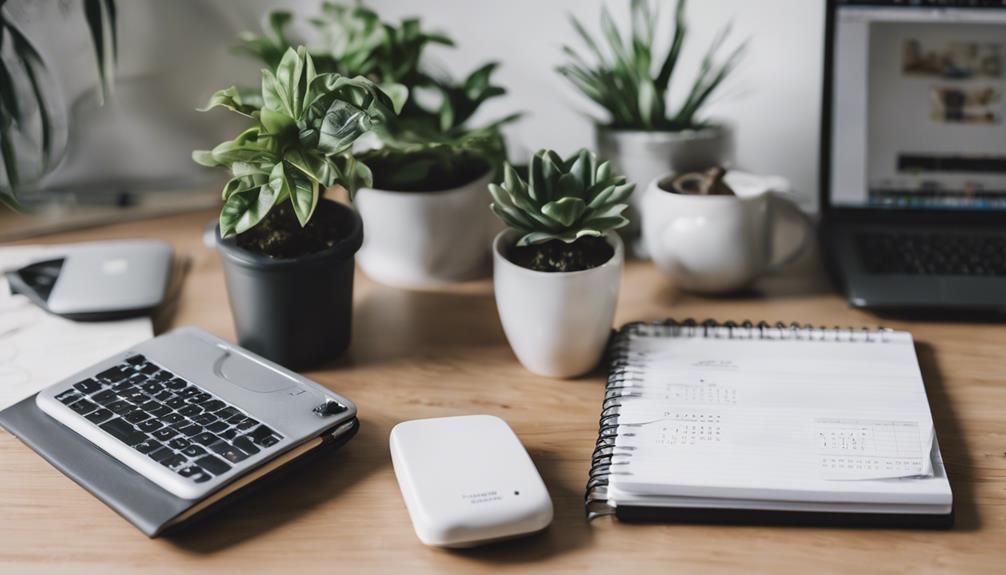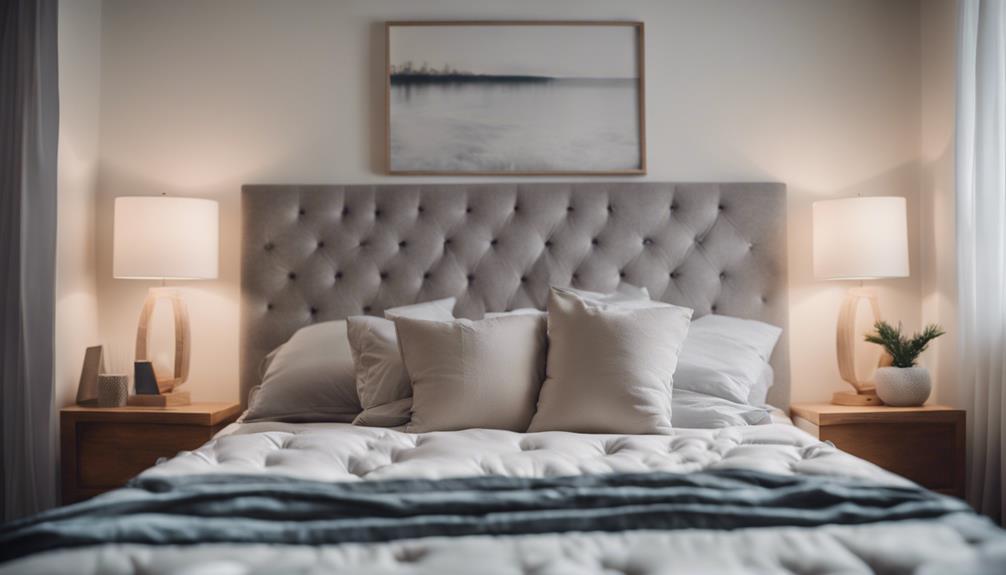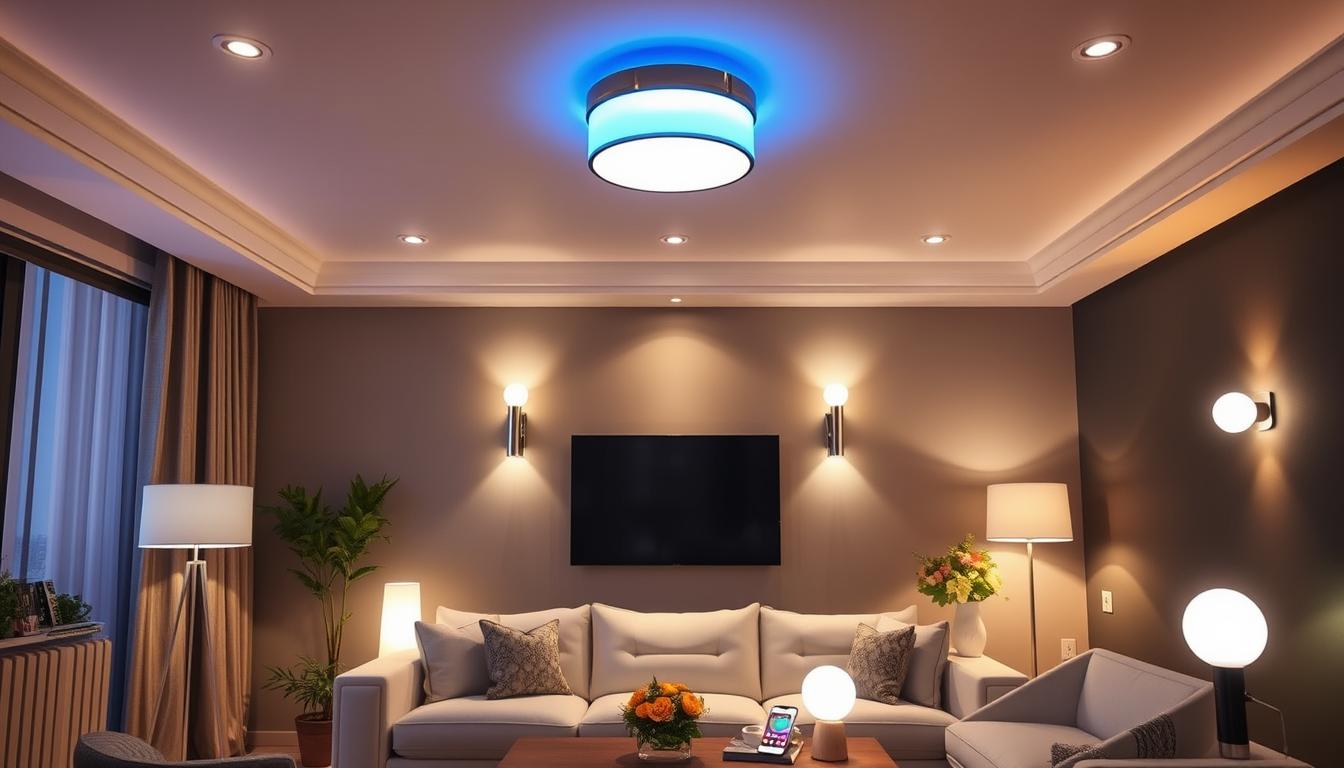Effective workspace organization is essential for productivity. Decluttering enhances focus, optimizing digital filing simplifies document retrieval, and streamlining the physical workspace boosts efficiency. Prioritize ergonomics with suitable furniture placement and storage solutions. Balancing work and personal life creates a harmonious environment. Boost creativity with personal touches and designated brainstorming areas. By implementing these strategies, individuals can create a conducive workspace for maximum productivity and well-being.
Key Takeaways
- Declutter and organize for a clear space and mindset.
- Implement a consistent digital filing system for efficient document retrieval.
- Optimize physical workspace layout for workflow efficiency.
- Prioritize ergonomics to enhance health and productivity.
- Create a balanced workspace for work-life harmony.
Decluttering for Efficiency
Decluttering your workspace is essential for maximizing efficiency and productivity. A tidy desk eliminates distractions and allows for better focus on tasks at hand.
By removing unnecessary items, one can create a more organized environment that promotes a clear mindset and enhances workflow. Regular decluttering sessions help prevent the accumulation of unnecessary clutter, ensuring that the workspace remains functional and conducive to productivity.
It's important to categorize and sort items, both physical and digital, to streamline access and retrieval. Implementing a simple filing system for papers and organizing digital files logically can greatly improve efficiency.
Clearing out outdated or irrelevant documents also prevents confusion and saves time when searching for essential information.
Optimizing Digital Filing Systems

To effectively manage digital documents and enhance productivity, optimizing digital filing systems is key. Organizing files into clearly labeled folders and subfolders helps streamline document retrieval.
It's essential to name files logically, ensuring easy identification and categorization. Utilizing cloud storage or external hard drives for backups adds an extra layer of security to important files.
Implementing a consistent naming convention across all documents aids in quick searches and reduces confusion. Regularly decluttering and archiving old files prevent digital clutter and promote a more efficient workflow.
Streamlining Physical Workspace

Efficiently organizing physical workspace promotes productivity and enhances focus. To streamline the physical workspace effectively, individuals can:
- Declutter and Simplify:
- Remove unnecessary items.
- Keep only essential tools within arm's reach.
- Create designated spaces for different tasks.
- Optimize Layout:
- Arrange the desk to minimize reaching and maximize comfort.
- Position frequently used items strategically.
- Guarantee adequate lighting.
- Establish Zones:
- Create distinct areas for different activities such as working, brainstorming, and relaxing.
- Use storage solutions like shelves or drawers to maintain each zone organized.
Enhancing Ergonomics and Health

Creating an ergonomic workspace is essential for promoting health and productivity in a home or office setting. Ergonomics focuses on designing the workspace to fit the individual's needs, reducing strain on the body and minimizing the risk of injuries. Here are some key elements to contemplate:
| Enhancing Ergonomics and Health | |
|---|---|
| Choose ergonomic furniture | Prevents discomfort |
| Position computer at eye level | Reduces neck strain |
| Use a supportive chair | Maintains good posture |
| Keep frequently used items within reach | Minimizes reaching and twisting |
| Adjust desk height to elbow level | Prevents wrist strain |
Boosting Creativity Through Workspace

Enhancing creativity in the workspace involves intentional design choices and personalized elements that inspire innovative thinking.
To boost creativity effectively, consider the following:
- Incorporate elements that reflect personal interests or aspirations.
- Integrate colors and textures known to stimulate creativity.
- Create designated areas for brainstorming or idea generation.
Balancing Work and Personal Life

Achieving a harmonious balance between work responsibilities and personal life is essential for overall well-being and productivity. By setting clear boundaries and routines, individuals can effectively manage their time and energy.
Designating specific areas for work and leisure within the home office helps create a mental separation between professional tasks and personal activities. Implementing visual cues like lighting or room dividers can help delineate different zones and signal shifts between work and relaxation.
Establishing rituals to mark the beginning and end of the workday assists in maintaining a healthy work-life balance. Additionally, scheduling time blocks for personal interests outside of work commitments allows individuals to recharge and engage in activities that bring fulfillment, ultimately contributing to increased productivity and overall satisfaction.
Maximizing Productivity Benefits

To optimize productivity benefits, streamline workspace organization, and efficiency practices.
- Prioritize tasks based on urgency and significance to tackle important responsibilities first.
- Implement time management techniques to allocate dedicated focus periods for specific tasks.
- Regularly assess and adjust workflows to identify and eliminate inefficiencies swiftly.
Frequently Asked Questions
How Can I Incorporate Feng Shui Principles Into My Workspace Design?
Incorporating feng shui principles into workspace design enhances energy flow and promotes harmony. Positioning furniture to face the entrance, utilizing natural light sources, and adding elements like plants or water features can create a balanced and positive work environment.
Are There Specific Colors That Can Boost Productivity in a Workspace?
Specific colors, like blues and greens, can boost productivity in a workspace. These hues promote calmness and focus. Consider incorporating them in your office design to enhance work efficiency and create a conducive environment.
What Are Some Effective Ways to Reduce Distractions in a Home Office?
To lessen distractions in a home office, one should declutter, establish clear work zones, and set boundaries. Implementing routines, using visual cues, and minimizing interruptions can enhance focus and productivity in a conducive work environment.
Can Scent Play a Role in Enhancing Focus and Creativity in a Workspace?
Scent can play a role in enhancing focus and creativity in a workspace. Aromatherapy with scents like citrus or lavender may promote alertness and relaxation, aiding in concentration and sparking creative thinking for improved productivity.
Are There Recommended Ways to Personalize a Workspace for Optimal Productivity?
In crafting a productive workspace, personalization is key. Adding items of meaning and selecting decor that resonates can boost motivation and focus. Creating a space that reflects one's identity nurtures a conducive environment for peak productivity.
Conclusion
In the pursuit of peak productivity, a well-organized workspace serves as the foundation for success. By decluttering, optimizing digital systems, streamlining physical spaces, and prioritizing health, individuals can create an environment that nurtures efficiency and creativity.
Balancing work and personal life further enhances productivity, creating a harmonious equilibrium. By implementing these strategies, individuals can transform their workspace into a hub of productivity, creativity, and overall well-being.










